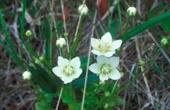Belozor swamp

Popular names: single leaf, student rose, marsh heart, white hepatic flower. Used parts: flowering aboveground part of the plant. Pharmacy name: herb marsh grass - Parnassiae palustris herba( formerly: Herba Parnassiae palustris).
Botanical Description
A ribbed erect stalk grows from a root rosette of entire, cordate leaves with long petioles, which carries a single stalk-encrusting leaf. Its top is adorned with a pure white single flower. On the petals, absolutely transparent veins are conspicuous. The inner part of the flower is also noteworthy: 5 white fimbriate appendages - modified stamens. Blooms from July to August. Occurs in marshy meadows, in damp trenches and in swamps. Collection and procurement. Collect the grass during flowering. It easily and quickly succumbs to air drying.
Active ingredients
Not sufficiently studied yet. Along with the tannin, there must be other active substances, without which some of the actions of this plant can not be explained.
Healing action and application of
Undoubtedly, this curative plant is still very little investigated. In this regard, great care is needed in handling it. Therefore, consider the information presented here as information, and not as a guide to the application. With the help of the belozor, it seems that one can alleviate heartbeat, nervous anxiety, a state of arousal, and fears. Sometimes you read and hear that epileptic seizures are less severe in the treatment of a white eye. This information, however, is not enough to purposefully apply a swamp whaler, but they are enough to pay attention to it.
Application in folk medicine
Belozor was given to the people as a "white hepatic flower", as it, as the older herbalists say, "opens the locked liver".So, this curative plant is used against various diseases of the liver, biliary tract and digestive tract disorders. However, Belzor is not particularly popular in folk medicine.
Side effects of
As this plant is still very little known, caution is necessary.
